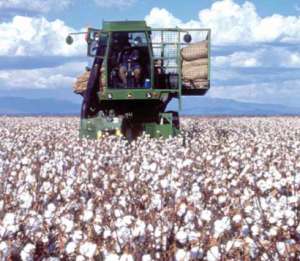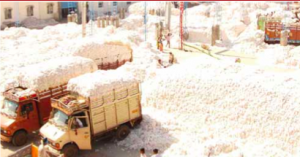 India’s cotton output is likely to dip by two million bales to 32.3 million in the 2012-13 marketing year (August-July) as farmers are likely to switch to better-priced alternative crops amid unclear cotton export policy, according to a report from the US Department of Agriculture (USDA).
India’s cotton output is likely to dip by two million bales to 32.3 million in the 2012-13 marketing year (August-July) as farmers are likely to switch to better-priced alternative crops amid unclear cotton export policy, according to a report from the US Department of Agriculture (USDA).
India, the world’s second biggest cotton grower, had produced a record 34.25 million bales in the 2011-12 marketing year. One bales contains 170 kg of cotton.
“Cotton production is forecast to decrease by two million bales to 32.3 million bales as the area is expected to drop by 10 per cent, the USDA report said.
But the domestic cotton consumption is expected to increase to 26 million bales in 2012-13, from 25.3 million bales in 2011-12.
However, India’s exportable cotton supply would be only six million bales in 2012-13 as against 11.75 million bales this year, given an expected drop in production and higher domestic demand, it noted.
On cotton acreage, USDA said gauging farmers’ planting intentions at this early stage is difficult. However, several factors suggest that the cotton area in 2012-13 will be lower at 10.9 million hectares as against the record 12.2 million hectares in 2011-12.
The record area planted in 2011 was influenced by the exceptionally high market prices that many farmers received following the harvest of their 2010-11 crop. While current prices are much lower than a year ago, prices are still above support price levels, which suggests that prices may be high enough to generate interest in cotton planting, but low enough to prompt some shift to alternate crops.
While the 2011-12 ending stocks-to-use ratio is forecast to drop to one of the lowest levels in at least 20 years, the current lower international prices are expected to depress the market signals that might have led to larger planting.
USDA, however, said that “if the Government of India increases the minimum support price (MSP) for cotton significantly, planting intentions could shift.” Farmers have a number of planting options, as high prices of peanuts, soybeans, guar and maize could prompt them to shift away from cotton in central, western and northern India, it added.
According to the report, Indian farmers may decide to try crops that are subject to fewer policy-driven market disruptions as it is not clear whether the Government will allow fresh cotton exports before the start of the 2012-13 marketing year or if the Government will develop a new procedure for regulating exports.
On March 5, India had banned cotton exports briefly for a week. It has decided to permit export of cotton that was registered before the ban period.
 On cotton yields, USDA said there is some concern within the industry that yields have stagnated over the past few years even as crop productivity has increased from an estimated 300 kg to 500 kg hectare since the introduction of biotech cotton. However, there is some concern within the industry that yields have stagnated over the past few years.
On cotton yields, USDA said there is some concern within the industry that yields have stagnated over the past few years even as crop productivity has increased from an estimated 300 kg to 500 kg hectare since the introduction of biotech cotton. However, there is some concern within the industry that yields have stagnated over the past few years.
“The increasing prevalence of ‘sucking insects’ such as whitefly, the need for better micronutrient and fertilizer management, the spread of cotton into dry-land areas and seed quality are all cited as factors affecting yields”, it said.
Given these ongoing challenges, yields are forecast at the five-year average of 500 kg per hectare, it said, adding that India’s cotton yields continue to be significantly lower than the global average of 740 kg per hectare.
The advent of biotech cotton has helped to improve the predictability and stability of cotton as a crop which has supported the expansion of cotton area in recent years. However, there is increasingly widespead opinion within the cotton industry that India’s cotton area will stabilize at least until there is another significant price or technology shift, within a range of 10-12 million hectares.
Cotton, a predominantly monsoon-season or kharif crop, is planted from the end of April through September, and harvested from October. With the area under Bt cotton and improved varieties now reaching an estimated 92 per cent of total area, prospects for future growth in productivity are limited as most cotton is grown under rain-fed conditions and on small farms, according to USDA.
There are an estimated 5.5 million cotton farmers with an average farm size of 1.5 hectares which limits their ability to adopt capital intensive production technologies and infrastructure. While some potentail exists for a further increase in yields, cotton farmers will have to make significant investments in production technologies for improved management of irrigation, fertilizers, micro nutriends, pests and diseases to boost yields above the current levels.
India accounts for about a third of global cotton area. Within India, two-thirds of cotton is produced in the central cotton growing zone, in the States of Maharashtra, Madhya Pradesh, Gujarat and Odisha where much of the crop is rain fed.
The northern zone, which consists of Punjab, Haryana and Rajasthan, produces cotton under irrigated conditions and accounts for about 15 per cent of production. In the South, Andhra Pradesh, Karnataka and Tamil Nadu account for 20 per cent of production. The central and southern zones typically grow long duration cotton that allows farmers to reap multiple pickings or harvests.
– PTI Economic Service